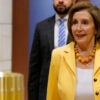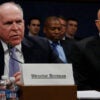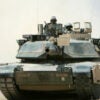The Afghanistan War appears to be over. After nearly 20 years of fighting, America’s longest conflict has come to a bitter conclusion. Afghanistan’s capital city, Kabul, fell to the Taliban in fewer than 72 hours. This came on the heels of a weeklong blitz that saw city after city capitulate to the Taliban.
How did this happen?
“This was an insurgency that for the past two decades was unable to capture even one of the 34 provincial capital cities in Afghanistan, but then out of nowhere, they sweep across the whole country and they’re sitting in the presidential palace in Kabul,” says Luke Coffey, a veteran of the Afghanistan War who directs The Heritage Foundation’s Douglas and Sarah Allison Center for Foreign Policy.
“It’s an utter disgrace and an extreme loss of prestige [for] the United States that President [Joe] Biden allowed this to happen,” Coffey adds.
Coffey joins “The Daily Signal Podcast” to help explain how the situation in Afghanistan deteriorated so quickly and what the implications are.
We also cover these news stories:
- Biden briefly returns to the White House from his vacation at Camp David to address the nation on Afghanistan.
- Taliban leaders declare “the war is over,” just short of 20 years since the U.S. invaded Afghanistan after the 9/11 attacks.
- At least seven are dead amid chaos at the international airport in Kabul when thousands of Afghan citizens desperately attempt to escape the invading Taliban forces. About 1,000 American paratroopers will be deployed to the airport to assist in evacuation efforts.
- House Speaker Nancy Pelosi says she is going to try to advance the $1.2 trillion infrastructure bill and the separate $3.5 trillion spending bill together.
Listen to the podcast below or read the lightly edited transcript.
Doug Blair: Our guest today is Luke Coffey, director of the Douglas and Sarah Allison Center for Foreign Policy at The Heritage Foundation and a veteran of the Afghan War. Luke, thank you so much for joining us.
Luke Coffey: Yeah, thanks for having me on.
Blair: Excellent. Over the weekend, we got a whirlwind of new information about what is going on in Afghanistan. At first we had heard reports that it would probably be around a month before the Taliban took Kabul, which is the capital of Afghanistan, and then we get this news less than 72 hours later that Taliban fighters are sitting in the presidential palace and seemingly have taken control of the country.
For our listeners who have not maybe been closely monitoring the situation, what is going on? Can you explain to them, how did this change so quickly?
Coffey: It is astonishing, it certainly is. Basically, President [Joe] Biden decided to go ahead and implement an agreement that was first made by President [Donald] Trump and the Taliban to withdraw all U.S. forces out of Afghanistan by May 1st.
When President Biden entered office, there were only about 2,500 U.S. troops in Afghanistan. They were there predominantly to train and advise the Afghan military. A smaller number of these 2,500 troops were involved in more of the high-end counterterrorism operations, the strikes against members of al-Qaeda or even ISIS that had taken roots in Afghanistan. It was a very small force that was there and they were not leading combat operations, the Afghans were leading combat operations.
May 1st rolled around and President Biden said that, “Well, it’ll take a little bit longer than May 1st. I hope to have them out by September 11th, on the 20th anniversary,” which, choosing that date was utterly daft because then it gave the timeline back to the Taliban on such an important date in American history. In the end, President Biden got all of the troops out by July Fourth, but a small force that was there to guard the U.S. Embassy.
Well, not only did the U.S. withdraw all of the forces from Afghanistan, but we also took out all the contractors that were there to help the Afghans with their maintenance and their logistics of their vehicles and helicopters and airplanes. We stopped providing, in any meaningful sense, all the close air support, the air support that the Afghan military was accustomed to having when they fought the Taliban. Then also, we stopped with some of the other intelligence-sharing mechanisms as well. This really left the Afghan army high and dry.
The Taliban sensed this and they decided to act. You already alluded to the timeline here, in the course of about 72 hours, the Taliban captured essentially the whole country without barely a shot being fired. This was an insurgency that for the past two decades was unable to capture even one of the 34 provincial capital cities in Afghanistan, but then out of nowhere, they sweep across the whole country and they’re sitting in the presidential palace in Kabul. It’s an utter disgrace and an extreme loss of prestige of the United States that President Biden allowed this to happen.
Blair: It just seems so shocking that this news was so rapid-fire. Now, given that our presence in Afghanistan goes all the way back to October 2001, post-9/11, would you be able to give our listeners a brief timeline of, from that time period, what we were doing in Afghanistan that brings us to today?
Coffey: Yeah, of course. Well, immediately after 9/11, if you go back and read President [George W.] Bush’s speeches and statements about the U.S. military intervention in Afghanistan, it was clear that there were two main U.S. goals.
One was to remove al-Qaeda from Afghanistan so al-Qaeda can no longer use the country as a safe haven to plan and coordinate terrorist attacks across the globe. And then the second goal was to punish the Taliban, to remove the Taliban from power, because they refused to hand over [Osama] bin Laden. President Bush gave the Taliban an ultimatum, gave them a date, and said, “If you don’t hand over bin Laden, we’re removing you.”
Both of these objectives were accomplished relatively quickly, you could argue almost by the spring of 2002. But in the spring of 2002, the World Trade Center was literally still smoldering and I don’t think Americans were quite ready to just pack up and come back home.
Then slowly but surely, this mission to deny al-Qaeda this safe haven and the mission to punish the Taliban morphed into a nation-building one. Year after year, many American commanders thought if they could just pave one more road, if they could just build one more school or open one more hospital, they could leave Afghanistan just that much better.
This evolved over the years and kept going. Finally, until about 2010, 2011, the U.S. decided to surge forces, President [Barack] Obama surged forces, where the U.S. had over 100,000 in Afghanistan up from about 70,000 at the time before the surge, with the condition that by 2015, the Afghans will be leading combat operations. The U.S. would surge forces, help train the Afghan military, and then we would slowly withdraw.
By the time President Trump got into office in 2017, the Afghans were leading combat operations, they were fighting very bravely against the Taliban, and the U.S. had about 17,000 forces remaining in the country from the height of over 100,000.
By the time President Biden got into office earlier this year, there were only 2,500 troops left. What’s astonishing is that these 2,500 troops, along with the air support and all the maintenance and logistical support we provided to the Afghans, that was enough to keep the Taliban out of power. It may not have been enough to ensure that the Afghan government totally won the war, but it was enough to make sure that the Taliban didn’t win the war and that was really the ultimate goal.
It was also a sustainable force in my opinion, as well. We were spending about $18 billion a year in Afghanistan when President Biden entered office. To put this into context, at the height of the fighting in 2010, 2011, 2012, the U.S. was spending $120 billion a year in that country. Last year, we spent for the whole year what in 2011 we were spending about every month and a half in Afghanistan.
If the alternative to having the small U.S. force in Afghanistan was for the Taliban to fully take over the country, then I think any reasonable person now would see that it would have been responsible to keep this small military force in Afghanistan.
Blair: Absolutely. Now, one of the things that I think is very striking is you’ve mentioned a couple of names here, you’ve mentioned al-Qaeda, you’ve mentioned the Taliban. I think it might behoove our listeners, can you briefly describe who the Taliban are and what they were doing that they were able to advance so quickly from nothing to everything so fast?
Coffey: Yeah. Well, the Taliban is a movement that started in Pakistan in the refugee camps in the early to mid-1990s as a result of all the refugees that fled into Pakistan during the aftermath of the Soviet invasion of Afghanistan in the 1980s. They swept into power in the mid-90s in the Afghan civil war and eventually captured most of the country. At their high water mark, let’s call it September 10, 2001, the day before 9/11, they controlled about 90% of the country, but they didn’t control the whole country.
There was another group called the Northern Alliance who was up in the north of the country that were resisting the Taliban and held the remaining 10%. After 9/11, we started backing the Northern Alliance with special forces and air support, and they were the ones that ousted the Taliban from Kabul with just several hundred U.S. troops on the ground.
It’s a sad geopolitical irony that on September 11, 2021, the Taliban will control more of Afghanistan than it did on September 11, 2001. That’s because of the events that we saw unfold over the weekend, over the past few days.
The Taliban itself, after being ousted, dispersed. Some people melted back into the population, others sought refuge in Pakistan. Some even sought some refuge in Iran, but that’s a very complicated situation, it’s not quite as black and white as the Pakistan situation was.
Then over the years, they had a crisis in leadership in the Taliban, where different factions were competing for one another. In many cases across Afghanistan, the insurgency became localized. It wasn’t necessarily that the upper echelons of the Taliban leadership were calling the shots, it was local commanders driven by local desire and ambition were calling the shots in their local area.
That’s why it’s interesting to point that out, because one of the successes of the Taliban over the past week is their ability to convince local leaders and local tribal leaders to switch sides, like they turned on a dime, even established anti-Taliban warlords switched to the Taliban.
I think there’s a number of reasons why they did this, and I think the predominant reason is for survival. They felt abandoned by America. Not only did we withdraw all of our forces, in the case of Bagram Airfield, we closed it in the middle of the night and just left. We took all the logistical support, as I mentioned, and the close air support with us, and the Afghans felt abandoned. These are people who also have families they need to protect and look after, so I think that’s why we saw a lot of these local leaders flip sides to the Taliban, because the Taliban were perceived as winning.
Well, on top of the Taliban and the Afghan government, you have a small presence of the so-called Islamic State, it’s called ISIS-K, Islamic State Khorasan.
Khorasan is a historical geographical region named for the region of where part of modern-day Afghanistan is. But they’ve been very limited in their ability to have any meaningful impact. They have controlled, at their height, several small districts, and there are over 400 districts in Afghanistan, so we shouldn’t confuse districts with provinces, of which there are only 34.
They were able to control some districts in Afghanistan, but paradoxically, everyone was fighting them, even the Taliban. In fact, there were cases that at least were reported in the media that, at times, the U.S. would conduct airstrikes against ISIS while the Taliban were fighting ISIS.
Blair: Very quickly, I would like to ask you a question, because I think this is so fascinating that you’re mentioning there were all of these forces in play. One of the things that I think a lot of people are asking is, was there anything we could have done to prevent this collapse from happening, other than maintaining a presence in the country, or was this an inevitability as soon as we pulled out?
Coffey: Yes. The only thing that President Biden could have done was to maintain the status quo. The problem with this is that Americans have been fed this line about ending forever wars for several years now.
I mean, this started with President Trump and it continued with President Biden. The reality is that the U.S. presence in Afghanistan today is nothing like it was as I described 15 years ago or even 10 years ago, where the U.S. had over 100,000 troops in Afghanistan, spending $10 billion a month, and taking serious casualties. The U.S. was able to keep the Taliban out with about 2,500 trainers and mentors, providing close air support and spending less than $20 billion a year.
Now, if you ask me if that is a price worth paying to ensure that the Taliban does not control the whole country, I would say yes, it is. But the American public had been told forever that we need to end so-called forever wars so this is the result of a lot of that rhetoric, in my opinion.
Blair: Definitely. Now, President Biden, as you said, has implied that the situation lies squarely at the feet of the previous president, President Trump. Do you find that this is an accurate assessment?
Coffey: It’s not accurate at all. President Trump was right to pursue a negotiated peaceful settlement to the fighting. This is how, often, most insurgencies end, is with some sort of political settlements, right? But where President Trump I think got it wrong was he wanted out as well, but he didn’t get out. That’s the big difference.
When President Trump came into office, he wanted out of Afghanistan, but he at least conducted an inter-agency review to determine what America’s interests in Afghanistan were and how to best preserve these interests. He didn’t fully withdraw.
President Biden comes in, he conducts no review whatsoever to determine his administration’s goals or objectives in Afghanistan. He says, “We’re getting out as soon as possible, regardless of the consequences.”
And now we have this desperate situation in Afghanistan with these horrific scenes out of [the] Kabul international airport, the white flag of the Taliban flying over the presidential palace, and now the Taliban in full control of the whole country. And not only in full control of the whole country, but they’re now in possession literally of billions of dollars of U.S. military equipment that we have given to the Afghans over the years—helicopters, fighter jets, small arms, machine guns, artillery, armored vehicles, you name it. Now, this is all in the possession of the Taliban.
All of this was avoidable by President Biden keeping a small force in Afghanistan.
Often I’m asked, “Well, President Trump’s plan was to withdraw them by May 1st.” Well, we don’t know what he would’ve done in a second Trump term. It’s impossible to prove it one way or the other. But what we do know is that President Biden had an opportunity to change policy. He’s a new administration, a new president, he could have changed policy and he chose not to. Now, we are where we are today. The blame lies squarely with President Biden in terms of what we’re seeing unfold today in Afghanistan.
Blair: Knowing what we do, that the Taliban has access to all this weaponry, it has total control of the country, it seems like the Afghan government is just completely dissolved. What do we do now? What do our allies and us do to limit the damage and consequences to both our friends in the region and to the homeland?
Coffey: Well, the consequences of what happened are unknown and will not be felt fully for probably years. The most immediate and pressing thing that we need to do now is to ensure that all U.S. personnel, diplomatic staff, civilians, American citizens that are in Afghanistan safely get out.
Also, we need to ensure that we can help get the Afghan nationals who helped the United States over the years out as well. Many of them put their lives in danger in serving as interpreters and translators. These were the people who cut our hair on the base when we were there, they cleaned our laundry, they often cooked our food. I think they have a reasonable expectation that the United States will look after them.
We see this chaotic, horrific scene playing out at the airport now. Again, one that would be completely avoidable had the administration taken the prudent steps to ensure that these people could get out safely.
That’s what we need to do in the short term.
In the longer term, we have to mitigate the spillover effect that the Taliban might have now controlling Afghanistan. We need to really up our game with counterintelligence and counterterrorism with countries in the region, especially Central Asian countries—such as Uzbekistan and Kazakhstan, we need to have some sort of serious dialogue with India about what is happening in Afghanistan. And we need to try to develop policies and strategies that can incorporate a U.S. footprint or a U.S. presence in the region in case we have to strike if there’s an immediate threat to the U.S. homeland.
Blair: Absolutely. Now, one of the other things I’m very curious about is some of the reporting has shown that the Chinese are very eager to start working with the Taliban-controlled Afghanistan. They’ve made overtures, the Taliban has also sort of made overtures back toward the Chinese. What are some of the international implications of the Taliban takeover of the country? Are there going to be acknowledgements of Taliban leaders as the rightful leaders of Afghanistan?
Coffey: Yes, I do think there will be. In the case of China, China is very pragmatic when it comes to its international relations. They have mentioned that they will engage and work with the Taliban.
Now, China has a problem. Well, China has many problems, but it has an international problem with the treatment of its Uyghur population. Its Uyghur population is a Muslim minority in western China that has been persecuted. Some have called, it in my opinion rightfully so, have called it genocide. It remains to be seen how the Taliban will view that aspect of China’s domestic policy.
But I’m not so sure that China is just going to swoop in and start extracting minerals and everything else from Afghanistan. It’s a very chaotic situation on the ground in Afghanistan, the dust hasn’t settled. It will be very difficult, at least in the beginning, for China to get too involved in Afghanistan because it’s so chaotic. I think Beijing will probably wait and see how things unfold.
Blair: Interesting. Now, Luke, we are running a little bit low on time, but I wanted to get your opinion. As we mentioned at the top, you are a veteran of the Afghan War. As somebody that was there, that served, that fought, that experienced all of these things throughout that time, what does this feel like? How does this feel to see all of this happening on the ground?
Coffey: Well, most of my adult and professional life has had some sort of connection to Afghanistan. As you mentioned, I served there for a year in 2005, later on I ended up working for the British and I was a top aid to their defense secretary and I worked on Afghan policy issues from a British point of view. I visited Afghanistan in that capacity a number of times.
I’ve lost friends and colleagues and classmates in Afghanistan, but I love the country. I love its people, its history, its food, its very complex and different cultures. Like many veterans of the Afghan War, I have watched President Biden’s abandonment of Afghanistan in probably a state of shock and disbelief.
But that being said, my personal and emotional attachment to Afghanistan is not why I’m most saddened and disappointed by what President Biden did. Instead, I think it is knowing that we are less safe as a nation and that this whole debacle was so easily avoidable that gets to me most. When I think of the threat to U.S. interests, the hit against U.S. prestige and interests across the globe, that’s what really bothers me the most, that this was so avoidable.
You can’t get too emotional about it. There’s thousands of other vets in my same situation who just can’t believe what they’re seeing and many of us are wondering, what was it all for? At least in the past we could say, “Well, the Taliban is nowhere close to getting power back and also there’s been no terrorist attack against the United States that has originated in Afghanistan for the past 20 years.” Now, we don’t know if that will continue to be the case. Now, the Taliban fully controls the country, and like I said, they actually control more of the country now than they did on September 11, 2001, which is a complete tragedy.
Blair: I mean, it’s just a terrible situation all around. Well, Luke, first off, thank you so much for your service. Your country thanks you.
That was Luke Coffey, director of the Douglas and Sarah Allison Center for Foreign Policy at The Heritage Foundation and, as we mentioned before, a veteran of the Afghan War. Luke, thanks again for joining us.
Coffey: Thank you so much.
Have an opinion about this article? To sound off, please email [email protected] and we’ll consider publishing your edited remarks in our regular “We Hear You” feature. Remember to include the URL or headline of the article plus your name and town and/or state.






























